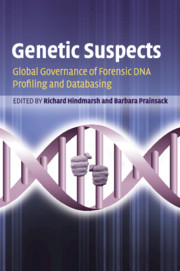Book contents
- Frontmatter
- Contents
- List of contributors
- About the contributors
- Foreword
- Acknowledgements
- 1 Introducing Genetic Suspects
- Section 1 Key areas in DNA profiling and databasing
- Section 2 National contexts of forensic DNA technologies and key issues
- 7 DNA databases and the forensic imaginary
- 8 Partners in crime: the use of forensic DNA technologies in Austria
- 9 Inquisitorial forensic DNA profiling in the Netherlands and the expansion of the forensic genetic body
- 10 DNA the Nor-way: black-boxing the evidence and monopolising the key
- 11 Portuguese forensic DNA database: political enthusiasm, public trust and probable issues in future practice
- 12 On trial! Governing forensic DNA technologies in the USA
- 13 Biosurveillance and biocivic concerns, from ‘truth’ to ‘trust’: the Australian forensic DNA terrain
- 14 Finding the balance: forensic DNA profiling in New Zealand
- 15 Forensic DNA profiling and databasing: the Philippine experience
- Section 3 Conclusions
- Index
- References
7 - DNA databases and the forensic imaginary
from Section 2 - National contexts of forensic DNA technologies and key issues
Published online by Cambridge University Press: 05 October 2012
- Frontmatter
- Contents
- List of contributors
- About the contributors
- Foreword
- Acknowledgements
- 1 Introducing Genetic Suspects
- Section 1 Key areas in DNA profiling and databasing
- Section 2 National contexts of forensic DNA technologies and key issues
- 7 DNA databases and the forensic imaginary
- 8 Partners in crime: the use of forensic DNA technologies in Austria
- 9 Inquisitorial forensic DNA profiling in the Netherlands and the expansion of the forensic genetic body
- 10 DNA the Nor-way: black-boxing the evidence and monopolising the key
- 11 Portuguese forensic DNA database: political enthusiasm, public trust and probable issues in future practice
- 12 On trial! Governing forensic DNA technologies in the USA
- 13 Biosurveillance and biocivic concerns, from ‘truth’ to ‘trust’: the Australian forensic DNA terrain
- 14 Finding the balance: forensic DNA profiling in New Zealand
- 15 Forensic DNA profiling and databasing: the Philippine experience
- Section 3 Conclusions
- Index
- References
Summary
INTRODUCTION
Technologies promising to provide reliable knowledge of individual human subjects are the constant companions of efforts to control personal and collective action in all societies. There is an extensive scholarly literature on the ways in which the historically and socially conditioned ‘interiors’ of such subjects, variously formulated as subjectivity, self-identity or ipse, have been constructed and interrogated in recent and contemporary social formations (see especially Foucault (1977, 1979), Martin et al. (1988) and Rose (1985, 1990, 1996, 1999)). Less well studied, at least until recently, have been the related efforts of a range of commercial, industrial and state agencies (especially security and criminal justice agencies) to acquire and use knowledge of the uniquely differentiated and securely fixed individualising characteristics of their employees, customers and citizens. Methods for reliably grasping and securing what passes for ‘individual identity’, ‘individuality’ or ‘idem’ are desiderata for any such agency seeking to attribute or evaluate claims of individual identifiability amongst the population members with which it deals. There is an increasingly large number of institutional actors who seek assurance that each individual with whom they deal can be differentiated from all others, and that there are ways of anchoring the changing biographies of such individuals to some ineradicable and unchanging bodily substrate.
It is widely asserted that a concern with the ‘legibility’ of such individualised identities is a key feature of modern state formations, and also that this concern has become intensified in many societies in the first decade of the twenty-first century, especially those that define themselves as being at risk from uncontrolled migration or from terrorist violence.
Information
- Type
- Chapter
- Information
- Genetic SuspectsGlobal Governance of Forensic DNA Profiling and Databasing, pp. 131 - 152Publisher: Cambridge University PressPrint publication year: 2010
References
Accessibility standard: Unknown
Why this information is here
This section outlines the accessibility features of this content - including support for screen readers, full keyboard navigation and high-contrast display options. This may not be relevant for you.Accessibility Information
- 17
- Cited by
